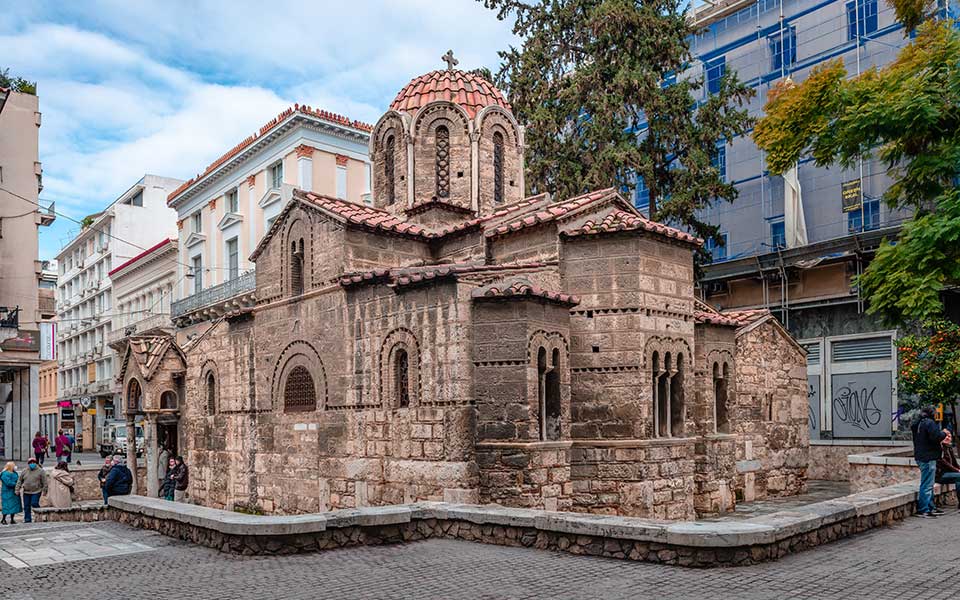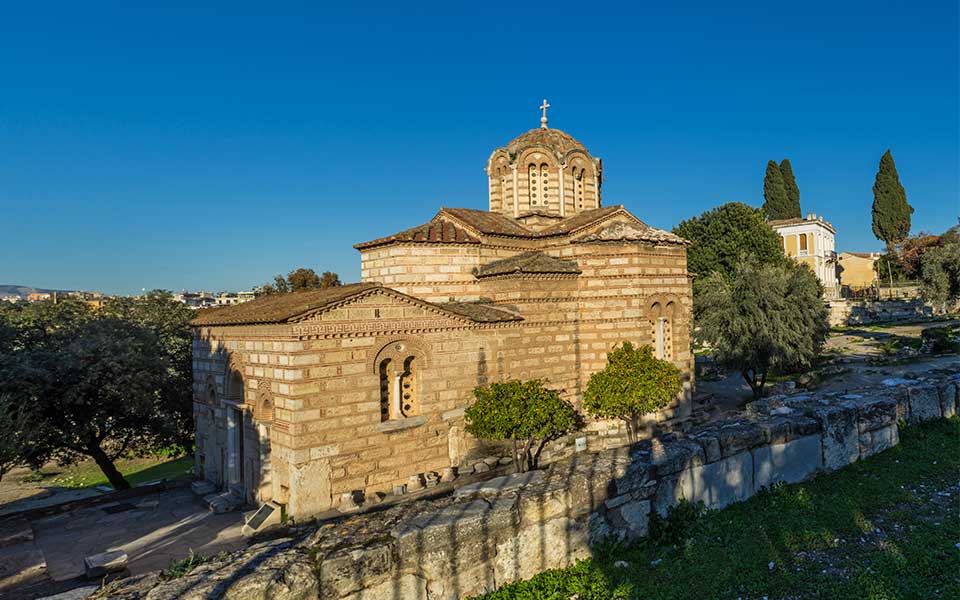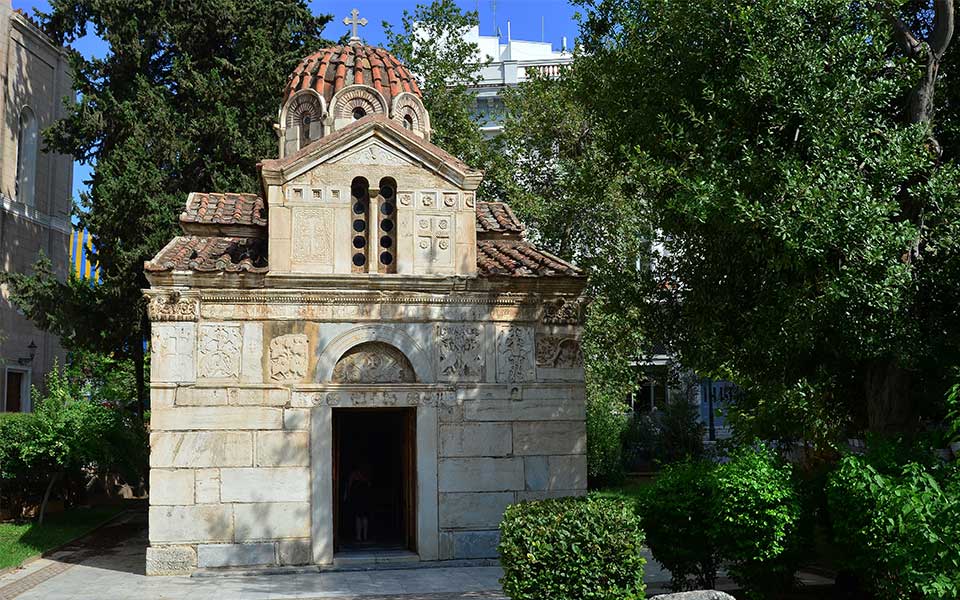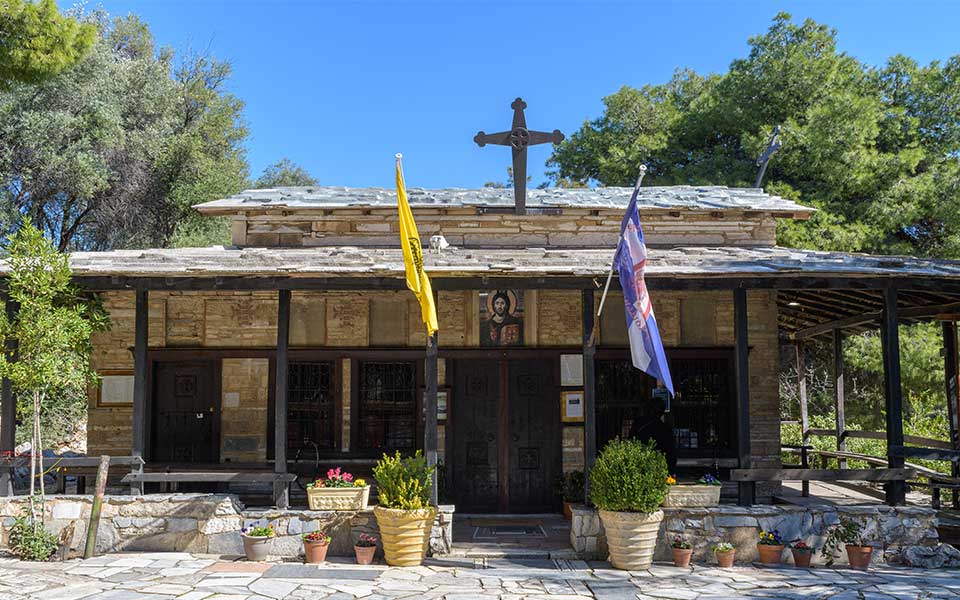Don Dines in Athens: O Skoufias, Pangrati
A hidden gem in Pangrati where...

The “Athenian Dome” of the Church of Panagia Kapnikarea, surrounded by modern commercial buildings on Ermou Street.
© Shutterstock
Athens, renowned for its ancient monuments and classical heritage, often overshadows another equally intriguing chapter of its history—the Byzantine era, spanning from the 5th century AD to the Fall of Constantinople in 1453. Nestled within Athens’ bustling heart is a handful of beautifully preserved churches from this fascinating period, offering a glimpse into a time when the city, long past its classical prime, experienced a renaissance in art and architecture.
During the Middle Byzantine period (843-1204 AD), Athens evolved from a provincial outpost into a hotbed of cultural expression and an important center of the Eastern Orthodox Church. Despite the ensuing centuries of foreign rule, the Orthodox Church established itself as a cornerstone of Greek ethnic identity, preserving cultural traditions, language, and religious practices, and serving as a great unifying force. In Athens and throughout the Greek world, the faithful responded to these trials by constructing remarkable churches that stood as symbols of resilience and faith.
Many of the churches built in the city during the 10th, 11th, and 12th centuries are distinguished by their unique “Athenian” architectural style, characterized by small proportions, intricate brickwork, and the iconic red-tiled, eight-sided domes—known as the “Athenian Dome.” These structures have withstood the test of time and continue to offer modern visitors a window into an often-overlooked chapter of Athens’ rich cultural history.
Below, we explore five must-visit Byzantine churches in downtown Athens, along with a bonus church that, though slightly off the beaten path, is well worth the visit. Regardless of your faith or beliefs, all are welcome to enter, respectfully observe, light a candle, or attend a service.

The Church of Panagia Kapnikarea, one of the oldest churches in Athens, is located right at the heart of the city, in the middle of the busy shopping area of Ermou Street.
© Shutterstock
The Church of Panagia Kapnikarea, located in the eastern section of Ermou Street, is one of the oldest and most important Byzantine churches in Athens. Constructed around 1050 AD, it was built over the ruins of an ancient pagan temple, likely dedicated to the goddess Athena or Demeter. The church’s architecture is a beautiful blend of early Christian and Byzantine styles, with its central dome and intricate brickwork standing out amidst modern commercial buildings.
The compact structure we see today is a complex of three interconnected units, built in succession: the main south church dedicated to the Presentation of Mary to the Temple, the northern chapel of St. Barbara, and the western exonarthex (outer porch) with its elegant propylon (gateway). The church houses notable icons, including works by the famous 20th century hagiographer Photis Kontoglou (1895-1965).
Kapnikarea’s survival is a story of historical preservation. In the 19th century, when king Otto I of Greece sought to modernize Athens with the help of Bavarian architect Leo von Klenze, the church faced possible demolition or relocation. However, it was saved by the intervention of Otto’s father, Ludwig I, king of Bavaria, who recognized its cultural value. Today, the church remains an active place of worship, and celebrates its saints name day on August 15, the Dormition of the Mother of God.
Located in the heart of fashionable Ermou Street, one of Athens’ main shopping areas, the church is easily accessible on foot from Syntagma Square or Monastiraki Metro Station, just a 5–10-minute walk away.

The late 10th-century Byzantine church of Aghioi Apostoloi lies on the edge of the archaeological site of the Ancient Agora.
© Shutterstock
Situated within the archaeological site of the Ancient Agora, the Church of Aghioi Apostoloi Solaki (Holy Apostles) is a textbook example of Middle Byzantine architecture. Built in the late 10th century over an ancient sanctuary dedicated to the Nymphs, it is the only church in the Agora that has survived intact. The church’s name likely originates from the Solakis family, who owned the property during the Ottoman occupation.
This small but elegant church is notable for its cross-in-square architectural style and beautifully preserved frescoes. The church’s masonry, constructed in the cloisonné technique—where stones are framed by bricks—features intricate ceramic decorations, including dentil courses and Kufic-inspired ornaments that imitate the Arabic alphabet, characteristic of the era. Its octagonal “Athenian” dome is supported by small columns and adorned with marble arched cornices above the windows, adding to its architectural charm.
The church underwent significant changes over the centuries. In 1877, repairs were made to address damage sustained during the Greek Revolution, and an expansion to the west was added, although this compromised its original aesthetic. Fortunately, between 1954 and 1956, the American School of Classical Studies at Athens restored the church to its Byzantine form, as part of their broader excavation efforts in the Ancient Agora.
Today, the Church of Aghioi Apostoloi Solaki stands as a testament to the continuity of worship in Athens from ancient times through the Byzantine era. Its interior features fragments of post-Byzantine frescoes and preserved wall paintings from the 17th and 18th centuries, salvaged from smaller churches in the Agora that were demolished during archaeological excavations.
The church is located within the archaeological site of the Ancient Agora, near the Stoa of Attalos. The nearest metro station is Monastiraki, a short walk from the site.

The Church of the Pantanassa or the “Dormission of the Theotokos” (Mother of God) is the 10th-century “katholikon” of a now-vanished monastery in Monastariki Square, between Athinas and Mitropoleos streets.
© C messier / Public domain
Dominating the lively Monastiraki Square, the Church of Panagia Pantanassa is a modest yet historically significant structure that can trace its origins back to the 10th century. The name “Monastiraki,” meaning “little monastery,” is derived from this very church, which once served as the katholikon (main church) of a now-vanished women’s monastery—the monastery cells would have been in the present-day square.
The church’s architectural style is a vaulted, three-aisled basilica, constructed with asymmetrical stones. Notably, ancient Greek capitals are integrated into its corners and its roofing design is Ottoman, symbolizing the blend of historical periods that characterize Athens. Approximately one-third of the church lies below the current ground level, a testament to the layers of history that have accumulated over centuries in this bustling urban center.
Though the church’s origins are rooted in the Middle Byzantine period, many of its features, including the bell tower and interior frescoes, are more recent additions. Much of the structure you can see today dates to the 17th century, while the bell tower, erected in 1911, replaced an earlier, more elaborate version built in 1890, which was considered aesthetically superior by art historians. Despite these later modifications, the church retains its spiritual and cultural significance, housing important Orthodox relics, such as icons of Saint Panteleimon and Saint Thekla, as well as hagiographies by the renowned painter Photis Kontoglou.
Throughout its long history, Panagia Pantanassa has witnessed both triumph and tragedy. It suffered significant damage during the Greek War of Independence and again during the devastating 1999 earthquake, which necessitated extensive restoration work. Despite these challenges, the church remains a beloved cultural jewel in the heart of Athens, revered by locals and visitors alike.
The Church of Panagia Pantanassa is situated in Monastiraki Square, right next to the Monastiraki Metro Station, making it one of the most accessible Byzantine sites in Athens.
Perched on the edge of the picturesque Anafiotika neighborhood, just beneath the slopes of the Acropolis, the Church of Aghios Nikolaos Rangavas is one of Athens’ lesser-known Byzantine gems, hiding in plain sight. Built in the second half of the 11th century, this historic church is closely associated with the prominent Rangavas family, whose most famous member, emperor Michael I Rangabe, reigned over the Byzantine empire from 811 to 813 AD.
The church’s architectural style is another classic example of the Middle Byzantine period, featuring the cross-in-square design with an “Athenian” dome. The exterior is adorned with cloisonné masonry and decorative elements including Arabic calligraphy and “Kufic” ornamentation, in similar fashion to the Church of Aghioi Apostoloi Solaki (see above). Inside, the church preserves remnants of an earlier 9th-century structure, including two ancient capitals: one embedded in the northeast side of the church and the other, a Corinthian capital, supporting the altar.
Aghios Nikolaos Rangavas is not only significant for its architecture but also for its role in Athens’ turbulent history. In 1687, during the Venetian siege of the Acropolis, part of the church was damaged by cannon fire. Despite these challenges, the church has remained an enduring symbol of resilience. It played a poignant role in Greek history when its bell was the first to ring out following the liberation of Athens from Ottoman rule on May 24, 1833, and again on October 12, 1944, marking the city’s liberation from German occupation.
Today, the church stands as one of Athens’ most important Byzantine monuments, offering stunning views over the city and a serene atmosphere that contrasts with the vibrant energy of the surrounding streets. Though it has undergone various architectural changes over the centuries, including the addition of the chapel of Aghia Paraskevi to the south, Aghios Nikolaos Rangavas retains its historic and spiritual significance.
The church can be reached by strolling through the narrow, winding streets of Anafiotika, the picturesque neighborhood nestled beneath the Acropolis.

The Church of Aghios Eleftherios, “Mikri Mitropoli,” adjacent the Metropolitan Cathedral of Athens.
© Shutterstock
Tucked beside the grand Metropolitan Cathedral of Athens in Mitropoleos Square, the Church of Aghios Eleftherios, also known as “Mikri Mitropoli” (Little Metropolis) or Panagia Gorgoepikoos (“Panagia [Mother of God] Who Grants Requests Quickly”), is a small yet remarkable Byzantine monument in the heart of downtown Athens. Built on the ruins of an ancient temple dedicated to Eileithyia, the Greek goddess of childbirth and midwifery, this tiny church, a mere 7.6m long and 12.2m wide, stands out for its unique architectural elements and rich historical layers.
Unlike typical churches of the Middle Byzantine period, Aghios Eleftherios is constructed almost entirely of “spolia”—reused marble blocks and reliefs from earlier Greek, Roman, and earlier Byzantine structures. Its walls are adorned with a frieze of 90 sculptural panels, blending ancient motifs with Christian symbols. The church’s cross-in-square layout, capped with an octagonal “Athenian” dome, adheres to Byzantine architectural norms, yet its façade, reminiscent of an ancient temple, sets it apart from other churches of the period.
The exact date of the church’s construction is debated, with estimates ranging from the 9th to the early 13th century. It is often attributed to the tenure of Archbishop Michael Acominatus Choniates, who served as the Metropolitan of Athens from 1180 to 1204. However, some historians suggest that the church may have been built later, during the early Ottoman period, due to its use of spolia and references from 15th-century accounts.
Originally dedicated to Panagia Gorgoepikoos, after a miraculous icon of the Virgin Mary, the church later became known as Aghios Eleftherios, the protector of pregnant women in Greek Orthodoxy. Throughout its history, the church has served various roles, including housing the public library of Athens in the 19th century. In 1856, it was restored to its original state, with recent additions removed.
Despite its diminutive size, Aghios Eleftherios has played a significant role in Athens’ history, most recently serving as the lying-in-state location for Constantine II, the last king of Greece, in 2023. Today, it remains a treasured link between ancient and Byzantine Athens.
Located in Mitropoleos Square, the church is easily accessible, just a short walk from Syntagma and Monastiraki Metro stations.

Church of Aghios Dimitrios Loumbardiaris, near Filopappou Hill.
© Shutterstock
A short walk from the city’s center, nestled at the foot of Filopappou Hill, lies the tranquil Church of Aghios Dimitrios Loumbardiaris. This 12th-century Byzantine chapel offers a peaceful retreat from the hustle and bustle of downtown Athens, surrounded by lush greenery that enhances its serene atmosphere. The church, a single-aisle vaulted structure, is believed to have been constructed with materials repurposed from ancient buildings, reflecting a deep connection to the city’s layered history.
The church’s name, “Loumbardiaris,” or “the Canoneer,” is steeped in local legend. During the Turkish occupation of Athens in 1648, the church was reportedly saved by a miraculous event. The story goes that Yusuf, the Turkish commander of the Acropolis, attempted to destroy the church and the congregation inside by firing a large cannonball, or “loumbarda,” from the Propylaea. Before the cannon could fire, a lightning strike blew up the magazine (powder house) on the Acropolis instantly killing Yusuf, thus sparing the church from destruction. This miracle has since become an integral part of the church’s identity.
Inside, the church features well-preserved frescoes that date back to 1732, adding to its historical and artistic value. The church underwent significant restoration in 1955, led by the renowned Greek architect Dimitris Pikionis (1887-1968). Pikionis, celebrated for his work on the pedestrian walkways around Filopappou Hill and other significant Athenian landmarks, carefully restored the church using paving blocks and marble salvaged from neoclassical buildings across the city.
Today, Aghios Dimitrios Loumbardiaris stands as a quiet haven, inviting visitors to reflect and appreciate the rich tapestry of Athens’ past. It is an especially popular venue for weddings and baptisms.
The church is located on Filopappou Hill, accessible via a pleasant uphill walk from the end of Dionysiou Areopagitou pedestrian street, or from Thisseio Metro Station.
A hidden gem in Pangrati where...
Beneath the busy streets of modern...
In 2006, inspired by a shared...
Discover how Christos, Athens’ master souvlaki...